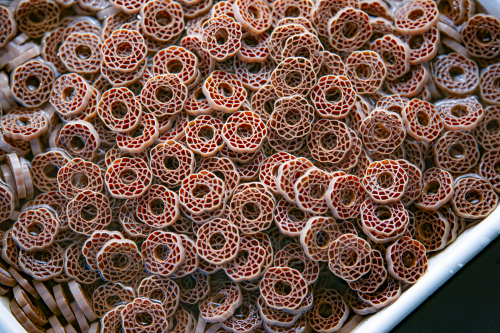
The Most Resilient
Two-Stage Anammox System
Pioneering new shortcuts in ammonia removal to municipal sidestreams, mainstreams, livestock wastewater, food processing wastewater, landfill leachate, and industrial wastewater.
Two-stage AMX™ ensures stable operation and rapid recovery
AMX technology utilizes short-cut nitrogen removal reactions that combines a partial nitritation (PN) reaction that converts half of ammonia into nitrous acid and an Anammox bacteria-enabled reaction that converts ammonia and nitrite into nitrogen gas. This technology is a next-generation water treatment solution that can reduce oxygen consumption and remove nitrogen from wastewater without an external carbon source.
-
Partial Nitritation Reactor
- Partial Nitritation using dense ammonia oxidizing bacteria(AOB) granules
- - Operation with high MLSS(6,000 ~ 8,000 mg/L) inside the reactor
- - Short settling time of 20 minutes(SVI less than 30)
- - Maximizing partial nitritation efficiency with aerobic conditions
-
Anammox Reactor
- Anammox reaction with dense anammox microorganisms attached to moving bed media
- - Securing high density anammox microorganisms in the reactor
- - Maximizing anammox reaction efficiency with anaerobic conditions

Busan Noksan
Wastewater Treatment Plant
The first full-scale application of Anammoxprocess in Korea
| Process
Mesophilic Anaerobic Digestion+ Anammox process
| Capacity
Mesophilic Anaerobic Digestion: 778 ㎥/d(0.21 MGD)(Sewage Sludge : 578 ㎥/d(0.15 MGD),
Food waste leachate: 200 ㎥/d(0.06 MGD)
Anammox : 780 ㎥/d (0.21 MGD)
* Based on WWTP design influent flow(184,000 ㎥/d, 48.6 MGD)
Realized economic breakthrough by reducing operating costs by 83%, capital expenditures by 64- 93%, and process footprint by 70 -90% compared to existing technologies
Applications
Municipal Wastewater Treatment
- Sludge dewatering centrate (Sidestream Treatment)
- Mainstream Treatment
High-Concentration Liquid Waste Treatment
Treat high-concentration nitrogenous industrial wastewater streams and landfill leachate in the most economical way
Securing Industrial Safety & Economy
Use in cases where economic feasibility does not materialize when treating low C/N ratio wastewater and if you need to consider energy independence
The AMX Advantage
Highest nitrogen removal rate in the market
More resilient to upsets: TSS, COD & ammonia spikes, NOB growth
Quick start-up, restart and recovery of AOB communities
Tomorrow Water’s Unique Anammox Species: Candidatus “Brocadia sinica” JPN1
Considered to be one of the best Anammox strains, Candidatus “Brocadia sinica” JPN1, demonstrates excellent growth rates in both high and low substrate conditions and maintains its activity even at high salt concentrations. It achieves 2x higher growth rates and has higher salinity resistance (up to 3%) compared to other Anammox strains.
AMX References
| Site | Application | Country | Capacity | Comments |
| Noksan STP (Busan) | Side-stream (Digester Centrate) | Korea | 780 m³/d | Operating (2023) |
| Daejon STP (old plant) | Side-stream (Digester Centrate) | Korea | 600 m³/d | Operating (2018) |
| Daejon STP (old plant) | Side-stream (Digester Centrate) | Korea | 1440 m³/d | Under Construction (2028) |
| Gangbyeon STP (Busan) | Side-stream (Digester Centrate) | Korea | 70 m³/d | Completed (Anammox farm for Noksan) |
| Daegu City STP | Side-stream (Codigestion) | Korea | 30 m³/d | Operated (2021-2022) |
| Hongcheon | Livestock/food waste digestate | Korea | 2.6 m³/d | Completed pilot plant |
| Muan City | Food waste | Korea | 90 m³/d | In Design (2026) | Goesan City | Food waste | Korea | 280 m³/d | In Design (2026) |
| Sudokwon Landfill (Incheon) | Landfill Leachate | Korea | 2 m³/d | Completed pilot plant (2020) |
| JWPCP | Main-stream | USA | 40m³/d | Completed demo plant (2015) |
| Hyperion Water Reclamation Plant (California) | Main-stream | USA | 40m³/d | Completed demo plant (2022) |
| Hyperion Water Reclamation Plant (California) | Side-stream (Digester Centrate) | USA | 1m³/d | Completed demo plant (2021) |
| Bos Dairy Farm (Indiana) | Livestock digestate | USA | 1m³/d | Completed demo plant (2018) |







